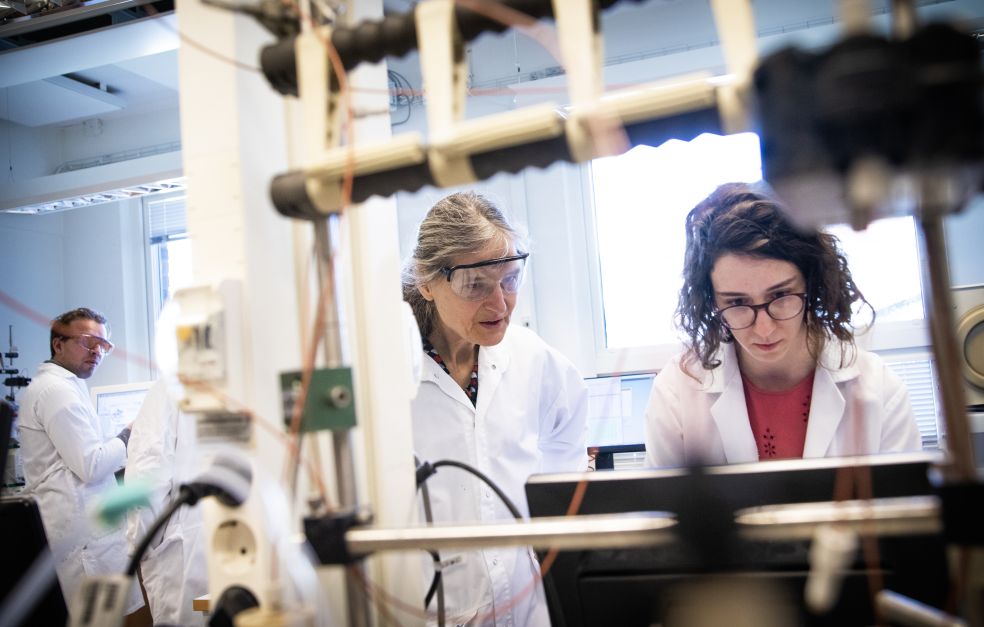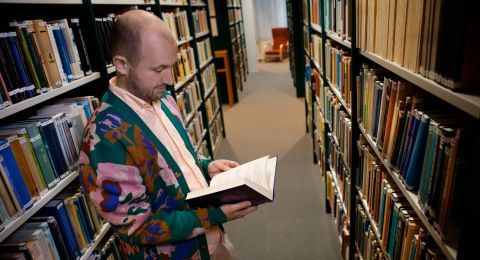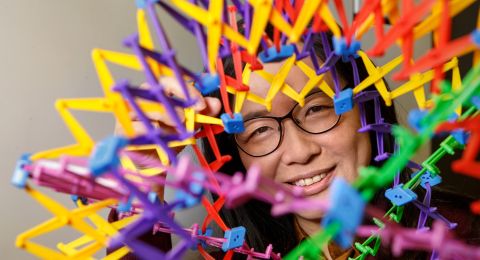
Project Grant 2022
The molecular mechanism and thermodynamics of chaperone action
Principal investigator:
Professor Sara Linse, Lund University
Co-investigator:
Lund University
Ulf Olsson
Institution:
Lund University
Grant in SEK:
SEK 27.3 million over five years
Chaperones are a group of proteins that help and support other proteins in our bodies. They make up as much as one-fifth of all proteins we produce, and help to prevent misfolding, among other things.
Some chaperones are known to increase the solubility of other proteins so they can exist in a higher concentration in solution than would otherwise be possible.
“This might appear to contradict the laws of thermodynamics. In every solution there is an equilibrium between the protein in dissolved and precipitated form. That equilibrium cannot really be changed using another player – unless another type of aggregate is formed, changing the phase equilibrium,” explains Sara Linse, Professor of Physical Chemistry at Lund University.
She is heading a research project funded by Knut and Alice Wallenberg Foundation. The aim is to study these chaperones in order to understand their effect. The researchers have formulated a hypothesis they call “the unhappy chaperone.” The name relates to an accepted description of the way that molecules can thrive to differing degrees in different environments. The formal name of this phenomenon is “chemical potential” – a potential that is higher if a molecule is not thriving.
Chaperones pining for company
The chemical potential of a given substance in a solution is the same in all phases of the substance. But when chaperones of a certain type are present in the solution something remarkable happens: equilibrium occurs with a greater proportion of the protein in solution and a smaller proportion aggregated, i.e. in precipitated (solid) form.
“We believe the chaperones have unusually high chemical potential. Hence, they do uncommonly poorly when they’re alone in the solution, and have a very low free concentration. If there is another protein to join up with, they will do so, and if there are no other proteins, they will combine with each other and form a self-aggregate.”
The Lund researchers believe the reason for the phenomenon is that the chaperone and the other protein form a kind of hybrid phase in which the protein acquires a different chemical potential than in its purely solid phase. A similar phenomenon is well known for smaller molecules than proteins. It is often exploited in drug manufacture, where drug molecules are allowed to form crystals with other chemicals so they become more soluble and hence easier for the body to take up.
Three key disease proteins
There is another possible explanation, i.e. that the chaperones form “micelles” together with the other protein. Micells are minute structures that embed the protein. The protein is not then rather than being more soluble, solubilized, i.e. hidden inside the micelles. But the researchers in Lund have already examined that possibility, and have used nuclear magnetic resonance to ascertain that the proteins were not inside micelles – at least not in the systems they have studied so far.
They have now chosen to study three chaperones that are structurally fairly disparate, but that seem to have the same kind of effect on the proteins that are impacted, known as “client proteins.” Three clients have also been selected that are of different size, structure and charge and that are involved in three diseases: Parkinson’s, Alzheimer’s and type 2 diabetes.
“Our interest in the project is purely scientific – we want to understand how and why chaperones manage to enhance solubility. But we have chosen these specific client proteins because they are associated with disease when they are dysfunctional. If we understood the phenomenon better, we might be able to create drug molecules with the same impact on solubility as the chaperones, or therapies that boost the body’s chaperones. We don’t develop drugs ourselves, but hopefully our findings will play a part in their development,” Linse says.
Open to other explanations
The researchers are combining numerous technologies, including electron and super-resolution microscopy, scattering techniques. optical and nuclear magnetic resonance spectroscopy. Linse’s colleague Ulf Olsson, who co-heads the project, specializes in studying surfaces and colloids, whereas Linse has many years’ experience of a wide variety of protein studies. They are also collaborating with teams across the world possessing special expertise on the various measuring methods.
“Preparing samples is the greatest challenge. Each sample has to be absolutely pure, since the chaperones may be potent at concentrations far below one per thousand client proteins. We need to exercise stringent control,” Linse says.
She herself admits that conducting hypothesis-driven research rather than studying a process without any preconceived ideas is somewhat unusual for her team. But sometimes it is better to start with that approach.
“The hypothesis can be used to design experiments, but when we interpret our data we have to have a completely open mind. If we have time, we want to study all nine combinations of chaperones and clients. It may very well turn out that one explanation applies in one instance, another in the next. And there might be a third explanation that we hadn’t thought of at all…”
Text Lisa Kirsebom
Translation Maxwell Arding
Photo Åsa Wallin





